Gaming In The Vietnam War – 50th Anniversary Of The Tet Offensive: Part One
January 22, 2018 by oriskany
They say we learn the most from our mistakes. If this holds true for nations as it does for people, then anyone with even a passing interest in military history, even a casual wargamer, should spend at least a little time looking at the Vietnam War.
Catch The Introductory Weekender Interview Here
What better time than now, with the 50th Anniversary of the Tet Offensive upon us? Fought in January, February, and March of 1968, the “Tet Offensive” was arguably the largest and most intense series of battles of the Vietnam War...its bloody and uncertain results proving crucial to determining the conflict’s final outcome.
To commemorate this milestone, this five-part article series will present an overview of wargaming the Vietnam War, while also taking a sharper focus specifically on the Tet Offensive. We’ll sketch in plenty of background, look at both sides’ objectives, plans, and tactics, and chart the course of this earthquake moment in modern warfare.
We’ll be discussing several wargaming systems during the course of this series, switching between them as best fits the particular engagement being examined. These will include “Tour of Duty” for Flames of War, Force-on-Force, and an updated Vietnam “re-skin” of Barry S. Doyle’s Valor & Victory (originally for WWII squad combat).
We hope to present some interesting background on Vietnam, a balanced look the Tet Offensive and some of its more important battles, and examine what made it such a watershed in late 20th Century warfare. Finally, we hope to show some “features” of Vietnam wargaming, and what makes it distinct from other conflicts.
A War Nobody Wanted
Summary Background
The Vietnam War has become a watchword for the misapplication (and sometimes abuse) of modern military power, and what happens when the strongest nation on Earth so grievously underestimates the opposition. Cold War politics aside, all the firepower in the world might not prevail against unyielding national will.
But how did this war start? How did the Americans even get here, never mind lose? Most immediately, how do these factors manifest as object lessons, not only in the realms of modern military tactics, doctrine, and geopolitics...but also on the wargaming table?
Vietnam had been a nation at war for a long time. Formerly part of the French colony of Indochina, Vietnam had been occupied by the Japanese during World War II. The American OSS (Office of Strategic Services) helped a resistance movement fight against the Japanese, the Viet Minh, under its charismatic leader, Ho Chi Minh.
After the war, the French wanted their colonies returned. The Americans didn’t universally support such “re-colonization” but needed French support for the founding of the UN and NATO. So the French returned to Vietnam, and war immediately broke out between their colonial forces and the Viet Minh.
This conflict came to a head in 1954 at the Battle of Dien Bien Phu. Here, a garrison of French (and allied) troops, heavily fortified deep in the backcountry of northern Vietnam, was surrounded by a large army of the Viet Minh. French commanders were confident that superior training, artillery, and air support would win the day.
The French, however, had badly underestimated Vietnamese determination, numbers, and ability to deploy huge amounts of their own artillery (288 guns, not including rockets and mortars). The Vietnamese commander, General Vo Nguyen Giap, was also exceptional and would cause the Americans years of grief in the decades to come.
The French stood no chance. Cut off, surrounded by massive Vietnamese artillery batteries on high ground, and subjected to human wave attacks, they pleaded with the US for help. But President Eisenhower turned down “Operation Vulture” which at one point even included the possible use of nuclear weapons to extract the French.
Although they’d won the war against the French, the Communists in Vietnam were bitterly disappointed by the peace talks which only gave them the northern half of the country. The southern half would remain a western-style democracy with its capital in Saigon, bolstered by grants and military support from the United States.
Soon enough, the old war had bled into a new one, this time against the Saigon government and its American supporters. At first, very few Americans were deployed in South Vietnam, but under President Kennedy and then Lyndon Johnson, more and more US troops were sent as the South Vietnamese government and army faltered.
After a controversial incident where North Vietnamese gunboats supposedly fired on US destroyers in the Tonkin Gulf, America was more or less committed to a growing anti-insurgent war in South Vietnam. Their mission was to defend and support their allies in Saigon, at least until the South Vietnamese could fight on their own.
Factions
As with most wars, the factions involved are a little more complex than “good guys” vs. the “bad guys.”
On the communist side, we have the formal army of North Vietnam, officially titled the People’s Army of Vietnam (PAVN), often called the North Vietnamese Army (NVA). Their overall objective in the war was to bring about the unification of North and South Vietnam into a single nation controlled by their communist government in Hanoi.
We also have the National Liberation Front (NLF). Often called the “Viet Cong,” this was a less formal communist insurgency in South Vietnam. These were not North Vietnamese, but South Vietnamese communist sympathizers or just people rebelling against the corrupt and ineffectual South Vietnamese government in Saigon.
This difference is an important one, for although the NVA and Viet Cong were obviously fighting on the same side, they had vastly different tactics, organization, and equipment – all of which will greatly affect any Vietnam tabletop army. They also greatly mistrusted one another, a factor fully evidenced in the bloodbath of the Tet Offensive.
For the “Free World,” we have the United States (Army and Marine Corps troops, Navy warships and carrier-based aircraft, and Air Force fighter-bombers and B-52s). Despite huge advantages in resources and firepower, US forces were hampered by policy limitations, discipline and morale problems, and even widespread drug abuse.
Also in the field is the Army of the Republic of Vietnam (ARVN), basically the South Vietnamese army fighting for the Saigon government. Although widely reviled as incompetent, cowardly, and prone to desertion and even atrocities, some units in the ARVN performed much better, including during the Tet Offensive.
Nations like South Korea and Australia also had smaller units fighting in South Vietnam. These were further supported by contingents from Thailand, New Zealand, Taiwan, and the Philippines - American allies with a keen interest in curtailing the spread of communism in the Asia-Pacific region.
The Tet Offensive
A Bid To End The War?
The Tet Offensive was an all-out effort by both the NVA and the Viet Cong, aimed at nothing less than the complete destruction of the South Vietnamese army and the collapse of the Saigon government. Sudden, overpowering, and widespread, its successful execution was expected to end the war at a stroke with a communist victory.
Scheduled for January 1968, the Tet Offensive is so-named because it was timed for the Tet holiday, the Vietnamese New Year which had in previous years seen an informal cease-fire observed by all sides. Massive numbers of ARVN troops went home on leave, and even US forces relaxed their alert postures as the war took something of a break.
Tet in 1968 would be tragically different. Instead, Vo Nyguen Giap, the general who had defeated the French at Dien Bien Phu, had coordinated a massive series of strikes by both his NVA “main force” regiments and divisions and Viet Cong guerrillas further south.
The communists would hit everything at once – military bases, highways, infrastructure, government centres, logistics, communication, all at the same time and with lightning bolt surprise. Lulled by the holiday ceasefire, American and especially South Vietnamese forces would be overrun without a chance for effective resistance.
The idea was to ignite a panic across all of South Vietnam, implode ARVN’s morale and cohesion, and start a massive popular uprising against the hated and corrupt Saigon government. Once in power, the new pro-communist government in Saigon would demand the United States leave South Vietnam. The war would effectively be over.
Although probably the largest single battle in the Vietnam War, the Tet Offensive is also the least typical in many ways. Usually, American and ARVN forces had to probe out into the countryside on “search and destroy” missions, hunting for an elusive enemy who denied pitched battle in favour or booby traps, snipers, and ambushes.
Not here. The Tet Offensive was one of the few times the NVA and especially the Viet Cong massed together and assaulted US and ARVN forces in full, frontal combat. We can almost look at it as “Vietnam in reverse,” often fought in burning city streets instead of jungles and rice paddies.
In some ways, this was exactly the kind of combat American commanders had been hoping for. But the shock of so many attacks, combined with widespread failures of many ARVN units, made this one of the bloodiest and most desperately-fought periods of the Vietnam War. American units were badly caught off-guard and paid accordingly.
In the end, the Tet Offensive would also show just how far the Americans were from “winning” this war, despite assurances the government had repeatedly made to the American public. Tet probably puts the final coffin nail in the Johnson Presidency, and fatally wounded American public support for the Vietnam War.
In a word, if you’re looking for a specific moment when the Vietnam War was actually lost, the Tet Offensive is a good place to start.
We hope you’ve found this first look into the Vietnam War and the Tet Offensive informative, maybe even inspiring. After all, there are multiple game systems out there that cover the Vietnam War, this could be your excuse to fire up some Jimi Hendrix, Stones, or Doors (8-tracks only, for historical realism) and “hit the bush” yourself.
Next week, we’ll look at the plans for the Tet Offensive in more detail, as well as wargames depicting some of the opening communist attacks. We’ll have street battles, assaults on American firebases, jungle firefights, village assaults, the full gambit of the Tet Offensive engagements. So stay tuned!
Meanwhile, have you played any Vietnam-themed wargaming yourself? How about “Tour of Duty” by Battlefront, “Charlie Don’t Surf” by Too Fat Lardies, “Force on Force” by Ambush Alley Games / Osprey (which started with their “Ambush Alley” Vietnam core rules)?
Post your comments, questions, and insights, and let's keep the conversation going!
"We’ll be discussing several wargaming systems during the course of this series, switching between them as best fits the particular engagement being examined..."
Supported by (Turn Off)
Supported by (Turn Off)
"...as with most wars, the factions involved are a little more complex than “good guys” vs. the “bad guys”"
Supported by (Turn Off)









































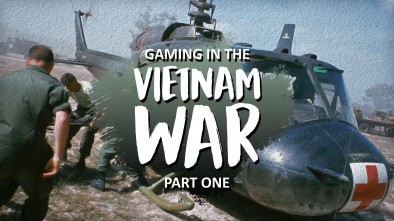
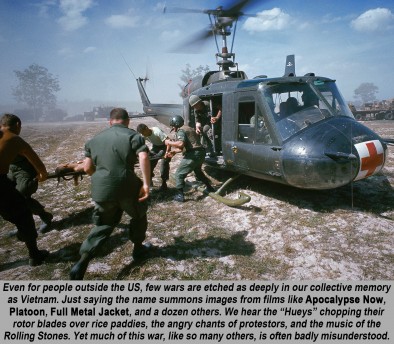
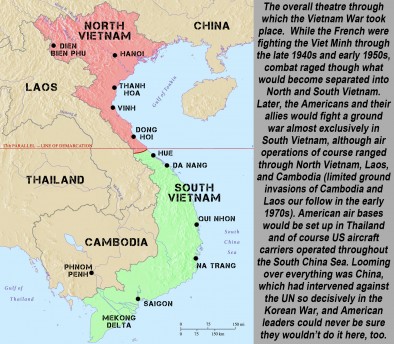
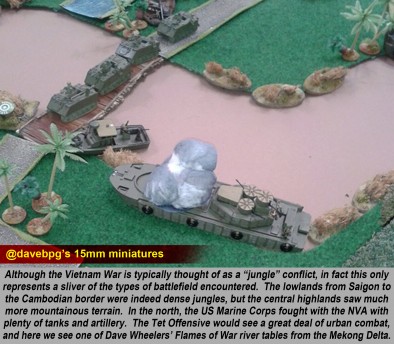
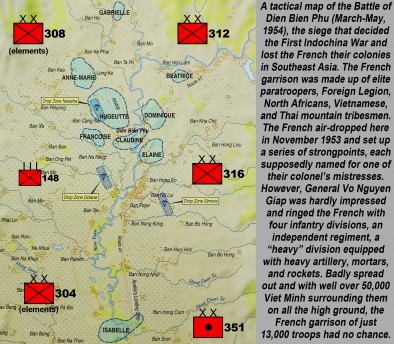
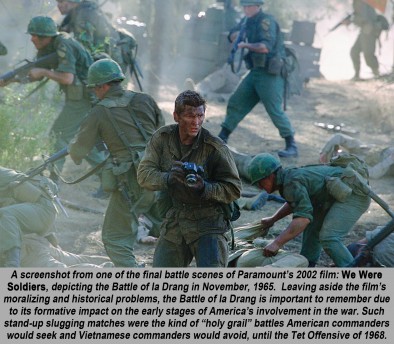
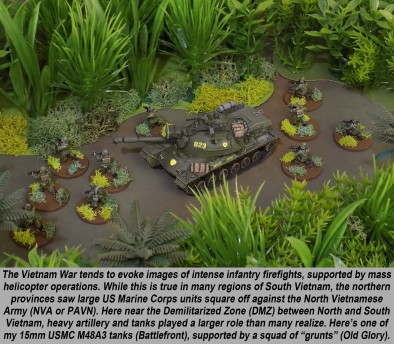
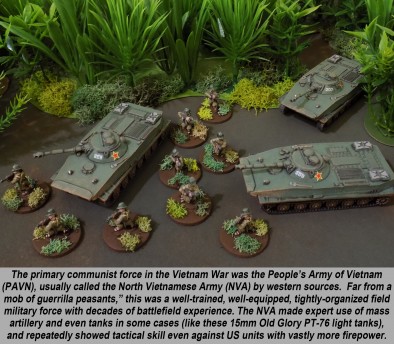
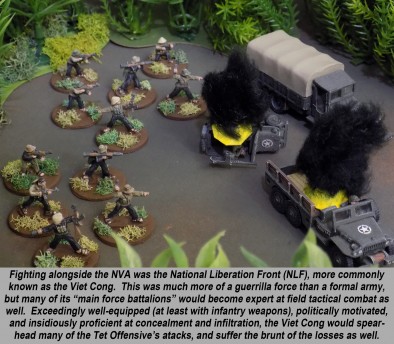
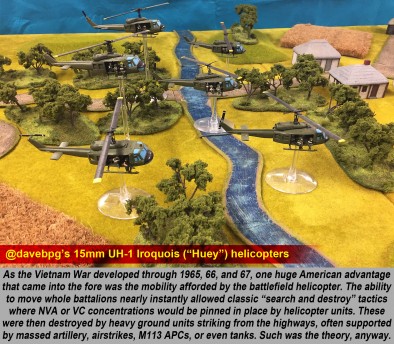
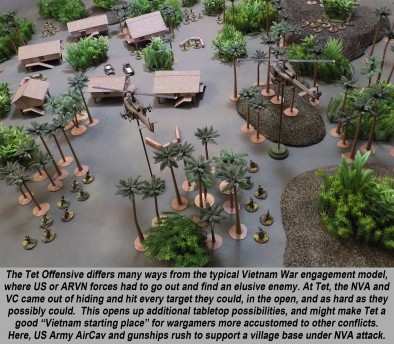
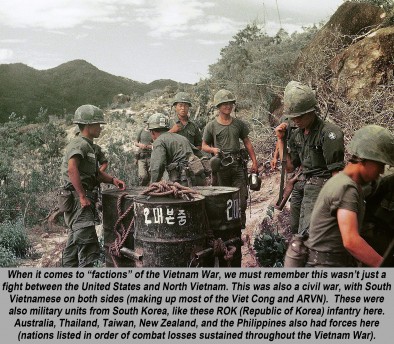
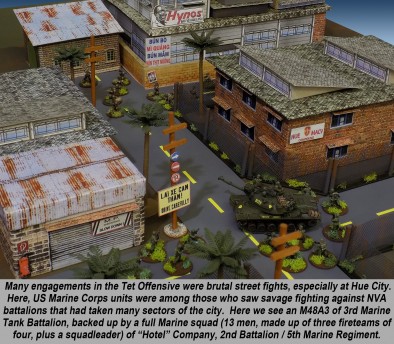


































https://carportgaming.blogspot.com.au/2017/03/letters-from-vietnam.html
https://carportgaming.blogspot.com.au/
Wow, thanks very much for the links, @c0cky30 ! I’ll definitely give this a read and once I get a little familiar with it, perhaps a try. Force on Force is probably by favorite post 1945 wargame, but seems to be written for slightly smaller battles than I really like. This might be the perfect fit. 😀 Thanks again!
No worries at all. Let me know if you have any further suggestions for the supplement or need anything further explained with the rules. Always willing to help. Just happy to see some NAM wargaming. Keep up the good work.
In this series, we’re using Force-on-Force (sometimes a streamlined version of the rules for faster play when the battles get larger) – and a re-skin of Barry S. Doyle’s Valor & Victory (updating from WW2 to Vietnam). @davebpg is helping us out with some Flames of War. When we start the support thread I hope to get some people on the forum with Charlie Don’t Surf, and who knows, maybe some of this Chain of Command DMZ. Vietnam is a tough conflict to get “right” – between factors like casualty management, asymmetrical firepower levels, mobility differences, off-board assets (that’s BOTH… Read more »
I’ve played Ambush Valley that was the Vietnam supplement for Force-on-Force…
Well kinda had too, as I wrote it.
Force-on-Force is probably my favorite post-1945 wargame. The troop quality mechanic at its base is very straight-forward, intuitive, and yet delivers such realistic results. Such differences in training and tactics of the MEN are so much more important in modern or modern-ish conflicts, rather than minutia on 5.56mm or 7.62mm or other technical details in equipment (where pretty much everyone’s carrying an assault rifle of one kind or another).
great article, again thanks guys!
Excited for the rest of the series, these series are not only a well of ideas for scenarios and campaigns but also very informative and I always discover things I wasn’t aware of before.
Thanks very much, @donlou ! We try to communicate, entertain, and if we’re really lucky / successful, maybe educate just a little. 😀 Of course, I often learn a lot from the comments, and I’ve definitely learned tons about wargaming from the community as well.
Sadly, the US never really seemed to learn anything, preferring to inventing their own version of the Dolchstoßlegende rather than taking the lesson of Vietnam to heart.
Politics aside, I must admit that I just don’t find Vietnam that interesting as a tabletop game. Search and destroy versus guerilla ambushes doesn’t lend itself well to gaming. In my opinion, anyway…
In any case, I’ll be looking forward to seeing what you can come up with.
@warworksdk – I would agree … partially … with what you suggest re: comparisons to the Dolchstoßlegende. If I understand correctly. Dolchstoßlegende is the self-promulgated myth where the German Army didn’t really lose in World War I, but was betrayed by the people at home. In a strict military sense, I don’t think the comparison holds up. The German Army in 1918 really was losing, they just hand’t completely collapsed yet. That cannot be said for the US military in South Vietnam, the numbers just don’t support that conception. In a broader sense that includes the media, social movements in… Read more »
Your answer to question two makes me excited to see how you could take more asymmetric games like S&D/ambush (I’m guessing they would be asymmetric?) and use them to influence the main point of a Vietnam campaign.
Like having smaller battles to influence points or strategies for a larger battle.
I have a question though, wouldn’t a game based on Tet start off unbalanced anyway? As the US would start unprepared? Or am I getting this all very wrong? 😛
(ps: basing all this on what I just read as my only exposure to Vietnam is Full Metal Jacket)
Good questions, @redyeti . 😀 Question one: Asymmetrical search and destroy For search and destroy games, we’ve found that enforcing casualty management on the American forces is pretty serious. The VC / NVA typically get 3 victory points for each US casualty, assuming he is SECURED and DUSTED OFF. This means medics, which take up space in the order or battle in the helicopters, don’t fight, and are vulnerable themselves to communist fire. Americans are also making checks each time a unit moves for booby traps. Americans can also not fire in anyway at civilians, including area effect weapons whose… Read more »
For a campaign, I don’t think you can avoid looking at US politic. Sorry… Once again those politicians are interfering… For the US – especially in the later part of the war – it’s all about managing casualties. The more casualties, the more demoralized them men get, the more fragging we see, and the louder the protests at home become. For the Americans then, the campaign is all about fulfilling their objectives before they’ve suffered so many casualties that the politicians have no choice but to seek an end to the war and get the boys home. But what are… Read more »
@oriskany – you write: For a campaign, I don’t think you can avoid looking at US politics. Sorry… Once again those politicians are interfering… Please don’t apologize, half the point of Part 05 of the series is how, in the age of televised media, symbolism and politics are a very real, tangible objective on the battlefield, and thus on the table top. In our Vietnam Valor & Victory game (we’re calling it “V3” for short) – I think we hit very close to what you’re saying about victory conditions and casualties. American units have to take given objectives (based on… Read more »
It wasn’t so much needing more troops. It was getting the US government to fight the ‘real’ war. Laos and Cambodia were the keys to winning the war, but no one would accept an outright invasion of these two ‘neutral’ states. It all came down to shutting down the Ho Chi Minh Trail and that required expanding the war into those nations… who were basically occupied by the Communists and were being used for the war. Check out this Quora: https://www.quora.com/Why-did-the-United-States-lose-the-Vietnam-War/answer/Randall-Case-2 Later in the war the US and ARVN did attack the trails to varying effects. It certainly brought the… Read more »
They did try to cut the trail, yes. And boy oh boy did the brown stuff hit the fan when people found out… Had the US officially invaded two neutral countries they would likely have lost what little support they still had for the war. Remember, they weren’t even supposed to be at war… Advisors, they called it… Yeah… Right… Add to that the logistical nightmare of having to fight a guerilla war in three countries where the general population were generally against them. There was no way that was going to happen. And the NVA knew that… In a… Read more »
@tgunner91 – sorry for the late reply, I only saw this post now (been following Parts 02 and 03). The question of “cutting the Ho Chi Minh” trail is a complex one. What it would have taken, what it would have cost, and benefits it would have yielded are all highly abstract variables. Later in the war (1969+) . . . I feel this would have been more effective than earlier in the war. Earlier in the war PAVN/NVA formations are often supported by local NLF / VC battalions already nested in South Vietnam, often supplied by corrupt elements elements… Read more »
We’ve been disagreeing on a lot lately, @warworksdk – but when you say: “They did try to cut the trail, yes” – I definitely have to agree there for sure. 😀 Looking at the numbers (two million tons of ordnance delivered via 580,000 bombing missions – so roughly the equivalent of 100 Hiroshimas over nine years) dropped on Laos – still the heaviest bombed country on Earth to my knowledge . . .
Yes, I think we can safely say the US did try to cut the Ho Chi Minh Trail. 😀
Awesome article I can’t wait to read the rest. Here in Australia we’re still trying to sort out Vietnam with some Veterans that served with 2nd D and E Platoon having to fight almost half a century to get the Government to admit they even existed. Vietnam was also our only war involving Conscription. Where did you get that amazing terrain in the last picture? I’ve played some Flames of War Vietnam but it’s never really stood out to me as a period I’d be interested to wargame. Although that was a while ago and maybe this series will give… Read more »
I know Jim is a big fan of papercraft terrain for getting impressive set ups on the table quickly and cheaply. It looks like that is another fine example of the card folders art 🙂
Thanks, @elessar . It always grinds my gears a little when I hear veterans’ troubles after Vietnam. Hardly the most original sentiment, I know, but as a small-time veteran myself, that just really gets to me no matter what country the soldiers served. Vietnam was also the only time to my knowledge the US Marine Corps had to accept conscripted draftees. Please rest assured we address the contributions of the 1st Australian Task Force (included units of New Zealand troops as well) in Part 04. In the “Vietnam-Edition” re-skin @aras and I have hammered out for Valor & Victory, I… Read more »
Thanks, @avernos . Yes, @elessar2590 – everything on that table is scratch-built, except the palm trees. I do use some Dave Graffam models for WW2 buildings, etc (I wouldn’t really call that “scrach-building”), but there isn’t really that much for modern-looking buildings. So I find skins, textures, or just straight-on images of buildings in Google Images, download, format in Photoshop, and make “wallpaper” for simple cardboard boxes. Windowsills and shutters are pasted on to give just a touch of 3-d effect. Even then, the buildings look pretty simple, but then you make a bunch of different sizes in such a… Read more »
Just putting this out there up front, some of the pictures I supplied Jim were taken by / with a friend Richard Covil (who’s forum name I don’t know) who deserves credit for the first “in game” picture on this article.
My bad, sorry guys.
Looking forward to another excellent series. Nam is a challenging setting to play against due to the nature of the warfare but get it right and it can be a very exciting and emotional roller coaster of a game. In short it rewards the investment of time and effort.
Looking forward to more stuff soon 🙂
Thanks very much, @davebpg – for the invaluable contribution to this article series. I won’t lie, at the outset of this series my Vietnam miniature collection was precisely zero. I spent all of December in a frantic buy/build/paint effort, but even now (150 infantry, five aircraft, and maybe 10 ground vehicles – plus terrain) I don’t come close to Dave’s collection. So his photos, plus his expertise in Flames of War: Vietnam, really make a crucial contribution to the big-scale battles of the Tet Offensive. 😀
Great start, can’t wait for the rest of the series. Have read quite a bit on Vietnam, looking forward to seeing your treatment of the subject.
Thanks very much, @gremlin – I look forward to hearing about what you’ve read, and how the series holds up historically. 😀 We’re focused, of course, on the Tet Offensive (granted, there was a lot of background in this first part). But we’ll be a little more zeroed in from here on out. And of course, with so many individual engagements in the Tet Offensive, we can only feature a sample. We tried to spread it out, with some in Saigon, outside of Saigon (Long Binh and Bien Hoa), then up north for the DMZ (Khe Sanh, Lang Vei, and… Read more »
While the conflict has always excited me from a visual point of view I’ve never played a table top game in Vietnam,
Often when watching movies like We Were Soldiers, I get the urge to do something but to date I’ve not gotten beyond the, “wouldn’t it be interesting to..” stage.
It looks like this will be another great article series and I’ll be watching out for the rest of them over the coming weeks, maybe I’ll go in country yet.
Superb work as always @oriskany
@avernos Weren’t you at the big one me and Jerry ran at Dragonslayers?. I thought you had been
sadly not, been to a few of the big games but I missed out on that one.
Thanks very much, @avernos ! Perhaps some kind of weird space-time portal may warp some of your Saga warriors into the Central Highlands! The heat may be a touch much for them but I’d bet they’d scare the hell out of some Viet Cong! 😀 😀 😀
the nekkid ones certainly would 😉
As Wellington (Justin) once said “I don’t know what they’re do to the enemy but the winkies terrify me!”
pretty sure that’s correct ^^
Good ole’ Justin. I didn’t have the heart to tell @thisisazreal – but one of those Vietnamese signs actually reads:
G.I. JUSTIN – NUMBER ONE GOOD TIME!
YOU GOT GIRLFRIEND VIETNAM?
Just kidding, of course. 😀 😀
For Vietnam games. Plastic aquarium plants are your friend
So very true, @torros . “Greenery Mats” at the craft store are even better (unless this is what you’re talking about) – you can get a 12″x 12″ slice of this for a couple bucks and even cut it into shaped sections. Or, you can pluck out individual “stalks” and use them to accent other mats.
http://www.michaels.com/10275721.html
I talked to some military chaps some years back who told me the British had ‘advisors’ in Vietnam.
true enough – remember looking into the British Advisory Mission to South Vietnam (BRIAM) when I was reading my degree. So called civilian operation made up primarily of veterans from Malaya – they trained hundreds of South Vietnamese in counter insurgency tactics as well as advising the government for the strategic hamlets programme. Also the possibility for some SAS involvement in the highlands but so far as I’m aware that’s still unproven, with a letter sent to the War Office from the British military attache in Saigon only suggesting how we could get involved. What isn’t conjecture is the involvement… Read more »
I think the SAS part tis what these guys were referring to
Thanks, @bigdave and @torros –
Also the possibility for some SAS involvement in the highlands but so far as I’m aware that’s still unproven …
Trust me, I checked. Whenever you publish anything on BoW it’s a good idea to check for British involvement. 😀 I’m not saying it didn’t happen, from a purely statistical standpoint it’s tough to prove a negative, but I didn’t find any verifiable records.
Information on the the BRIAM is very interesting, though. 😀
God, the Strategic Hamlets Program, what a disaster that was.
Another great read @Oriskany! A friend of mine has spent a number of years living in different parts of Asia and Australasia, when he was in Vietnam he spent a great deal of time in the north and was lucky enough to have visited Dien Bien Phu – meant to be an incredibly interesting place to visit, the whole area has barely changed with huge swathes of it preserved, the French positions of Beatrice, Isabelle and Elaine, the Muong Thanh Bridge and the De Castries’s Bunker. Nearby Muong Phang has example trench sections and you can even visit Giap’s staff… Read more »
That sounds awesome, @bigdave – I’m always struck by exactly where Dien Bien Phu was, it really is in the middle of nowhere. Kind of makes me chuckle when historians talk about how “remote” Khe Sanh or Lang Vei were. Dien Bien Phu sounds like it would be an amazing place to visit. I’m also kind of impressed with how the Vietnamese government has preserved so many of the battle sites. Sure, there’s pro-Vietnamese slant to the memorials, which makes perfect sense. I’ve always been a little confused by the plaque commemorating the four MPs and one US Marine who… Read more »
What a splendid start for the series! I can even add a tiny bit: General Giap was called the Vietnamese Napoleon, because he was so good as a commander. Dolchstoßlegende means “Stab in the back Legend”. The Germans, in particular Ludendorff, claimed, they hadn´t lost the war in the field (“Unbeaten on the Battlefield”), but had a dagger (=Dolch) thrust in their back and lost the war on the home front. I think this doesn´t apply to the Vietnam war. In WW I two further months of warfare would have the French, Brits and Americans stand on German soil and… Read more »
The RAF had plans to bomb Berlin by the Spring of 1919 while the army was keen to push the Germans beyond the Rhine – interesting to see how that would have effected the outcome of world history…
Damn, I never knew that. Suffice it to say that plans are in the works for at least one article series this year commemorating the 100th anniversary of the end of the Great War.
This is entirely new to me and this is a reason why I like to read historic stuff on BoW. I read quite a lot of material, but this … no. Didn´t know this. Thanks, bigdave. You´re verybigdave for me from now on.
Did the Brits have any long-range bombing planes in WW I?
I would defer to @bigdave – but I did find something on the Handley Page V/1500, a four-engine night bomber the British were intending to use to bomb Berlin. https://en.wikipedia.org/wiki/Handley_Page_V/1500 Don’t think it was ever used, though. Also: On 6 June 1918 the British formed the Independent Force under Major General Hugh Trenchard to engage in long-range bombing directed at industrial targets deep in German territory. Missions were undertaken with De Havilland DH9s and Handley Page O/400s, but the war ended before Britain’s four-engined Handley Page V/1500 bomber, designed to drop 7,500 lbs on Berlin, entered service. Ultimately, retaliatory bombings… Read more »
Hi @jemmy, @oriskany has hit the nail on the head in regards to the Handley – particularly in regards to French resistance to the use of terror tactics. Bombing industrial areas like the Ruhr was one thing, but mass strikes against population centres terrified the French as so many of their cities remained within sight of long-range German artillery. Last thing the French authorities wanted was retaliatory artillery strikes as a result of air raids from the nascent RAF (which was only formed in 1918). The scale of destruction from the allied air raids was tiny (emphasis on allied, the… Read more »
Thanks, @bigdave – again, not really my area, which is why I scurried off to Wikipedia just so I could provide some kind of answer. 😐 I know, I know … (hangs head in shame) … Wikipedia isn’t the best source for anything, but here’s the thing … at the bottom of most Wikipedia pages is a list of their sources, usually hyperlinked, so you can go straight to them and get better or more detailed information. 😀
True, the Americans seriously underestimated the opposition they were facing. And yet, I still hear many claim that the war was not lost on the battlefield but rather at home, with the brave GIs betrayed by cowardly politicians who wouldn’t do what was needed to win. A sentiment very much like that of the Dolchstoßlegende, even though the US was never in any danger the way Germany was at that point in time. As for one man teams, I seem to recall reading somewhere that the US would drop spec-ops behind enemy lines at various points in time, though I… Read more »
Thanks very much, @jemmy – YES, please add all you want – that is the point of these comment sections and gives us a chance to kick things around that couldn’t fit into the article itself. When I’m writing these within word-count constraints, I’m always having to leave things out, hoping “maybe someone will bring that up in the comments …” 😀 I agree that comparisons between the Americans in Vietnam and the Germans in WW1 are a little tough – BUT, I concede to @warworksdk that SOME of the American generals had some rather dubious impressions about how the… Read more »
@warworksdk – you write: “And yet, I still hear many claim that the war was not lost on the battlefield but rather at home, with the brave GIs betrayed by cowardly politicians who wouldn’t do what was needed to win.”
Sadly, I agree that this sentiment is sometimes present. I don’t agree with the sentiment at all, but have to confess than some in this country cling to it.
Any force on force Nam batreps planned?
Great question, @raglan – Full-length batreps for Force-on-Force in the article series … not really … only because such battle reports would basically take over the whole article. We do have tons of table photos, and talk about the game system and how it plays on the tabletop. BUT – As you may know, we always start a “support thread” for these article series, usually after two-three articles have published. In these threads, we have unlimited room and can other people can also post images and battle reports. So YES, we’ll have some full-scale Force-on-Force battle reports for them! After… Read more »
You’re are a beautiful man, I will look forward to those mate!!
You’re a beautiful man …
Well, Gal Gadot, Scarlett Johansson, and Charlize Theron certainly seem to think so.
I swear those three won’t leave me alone … 😐
ZZZZzzZZZ … continues to snore while dreaming … ZZzzZZzz …
lol.
Hey, a guy can dream, right? 😀 😀 😀
Around 30 years ago (gasp!), I picked up the Avalon Hill / Victory Games’ title ‘Vietnam: 1965-1975’ – a regiment/battalion scale game. With a friend we tinkered with the scenarios, finishing two I believe – the largest being the Battle for I Corps. We always looked at the full campaign, but the box estimate of 200+ hours to complete was grossly underestimated, in my opinion. The campaign rules added some interesting mechanics for offensives, though. The crux of the game was the balance between US commitment vs. morale at home. The FWA player was generally able to ramp up forces… Read more »
@donimator – Ah yes, the Avalon Hill operation-level game! These were my favorites, and actually, I Corps tactical zone is the part of Vietnam that has the most interest for me personally. I like what you mention about alert rolls before US / ARVN operations. This is another big advantage for the communist forces that helps offset the Free World advantage in firepower and resources. Corrupt elements in the Saigon government were constantly leaking intelligence to the communists. of course this would be worse for ARVN operations, but most US operations had to coordinate with ARVN, or at the very… Read more »
The Alert mechanic really captured the flavor. The NLF players also had the choice to just disperse (non-NVA units) with a unit’s combat strength value going back into the replacement pool – a minor overall loss vs the cost to create a unit, but the US player didn’t get the morale bonus for removing units. Interdiction could also be used before the check to make movement more costly. Key for the NLF player was having units in provinces and capitals to affect pacification of the SVN population. They are never looking for a fight in this game. … by ‘one… Read more »
I really like the idea of “dispersing” NLF units, how they’d just vanish into the countryside or melt back into the general population of a given operational area. Interdiction also makes sense. Having an NLF main force or even local sapper battalion in a given area means mines in the road, cut communication lines, extra troops needed for security sweeps, etc. – all of which would slow down a US battalion / regiment / brigade’s operational mobility and freedom of maneuver. “… by ‘one day’ I meant at some point in time :-p” Oh, I figured. Trust me, I remember… Read more »
One more point on the interdiction in this particular game – it was a support mission (mainly US) for artillery, naval gunfire or airpower to hinder movement through hexes in support of an operation. The combat value of that firepower was not used in the combat ratio for a particular attack, but you could make surrounding hexes 1 or 2 movement points more expensive to pass through hindering or making certain avenues of retreat less desirable. Coupled with a good combat result and a highly mobile attacker, they could keep up with retreating forces. Maximizing your pursuit was critical for… Read more »
Gotcha. Almost sounds like “Interdiction Fire” in the Arab-Israeli Wars tactical game, low-intensity artillery fire that could never do any damage, but could slow down any unit that tried to pass through its AOE. Egyptians batteries were great at this, slowing down companies or battalions of Israeli tanks that were trying to push through gaps in their entrenched infantry and/or minefields. I agree with the idea of scaling down the idea of operational interdiction to the tactical tabletop. In our games, we’re allowing artillery to be called in basically anywhere (at least if there’s a spotter helicopter or recon sections… Read more »
Took a look in my rulebook for the blurb at the start of the Tet Offensive scenario. Even through a mid-80’s lens, it seems a fairly accurate summary: The Tet Offensive of 1968 was the psychological turning point of the war. The American public had been told that the war was being won (and by some standards, this was true). Then the NLF launched a country-wide offensive. Scenes of battles and violence even in the streets of Saigon itself destroyed all confidence that the US was actually winning the war. In military terms, the offensive was a disaster; NLF military… Read more »
Sounds like an interesting mechanic, to have your own moral constantly declining.
Reminds me of the old Final Liberation game which had a similar mechanic. You really had to stay focused and keep your objective in mind, lest you ran out of moral before the enemy did.
I never played the full campaign to test it out but theory-crafted it plenty over the years. The US starts with high morale / low commitment. Between seasons (2 turns to a season) morale is modified. Every season you lose morale based on current commitment, new commitment, combat losses, SVN political leaders, bombing of the north, +more. You can mitigate that a bit by having some combat success without significant losses, but every season it will drop, even as you are pouring more resources in. NVA/NLF morale goes up based on new US commitment, allowing them to use more resources.… Read more »
Is this the old 40K turn-based tactics computer game?
One of them, yes.
Final Liberation was based on the Epic 40.000 game.
Awesome. 😀
@oriskany :
thanks for the start of yet another series of wargaming articles.
I never knew the VC were south vietnamese, but then my knowledge of Vietnam is limited to the Tour of Duty tv-series.
Lots of stuff to learn.
Thanks, @limburger – Ah, yes! The old Terry Knox Tour of Duty TV series. First season of that show was great. Attack on Firebase Ladybird was the best episode, I feel.
The intro pretty much sold ‘Paint it black’ and a lot of 60’s era music to me
https://youtu.be/0z6fcd–354
https://youtu.be/qV4Q-RSQCq0
I agree, @limburger – sadly, I read somewhere they got in a lot of trouble over this, apparently the song wasn’t properly licensed and they got the sh*t sued out of them.
Season Two they have different music for the intro.
Paint it Black is also the end theme to the Vietnam classic Full Metal Jacket.
a great start to the series the war was as clear as mud for most of the war will the Australian’s be involved in any of the tables, another thing about Nam the US air force had no cannon mounted fighters as the (expert’s) saying missiles are making guns obsolete.
Yes, @zorg , we do include a battle of “C” Company, 7 RAR (7th Battalion of the Royal Australian Regiment, 1st Australian Task Force) – which engaged 275th Rgt / 5th NLF Division north of Trang Bom, Dong Nai Province on 5 February, 1968. And yes, the initial F-44 Phantoms did not mount the traditional 6-barrel M61 Vulcan 20mm rotary cannon for air-to-air dogfighting, assuming missiles exclusively would be the new norm for dogfighting. Missiles definitely have their place, at long and medium ranges. Once it closes to short range, though, it’s tough for an American fighter pilot to get… Read more »
And the main reason they started the top gun program reteaching pilot’s shooting skills.
Miramar Naval Air Station, yep. 😀 Had a friend in the Marine Corps who was in one of our F/A-18 squadrons who got to go there (as a support technician, not as a pilot).
Wow… First up another good article, second, I have not read all the comments above… Lots very quickly. My thoughts on Vietnam. It is a conflict that has always fascinated me, not that I come anywhere near the knowledge of some of you guys, but for me it’s the political side of things I find more interesting than the military side. Don’t get me wrong be I think that there is lots of great opportunity to game in this period I haven’t had the opportunity. Unless you count running around as a kid with a toy M16. Looking forward to… Read more »
Awesome, thanks @commodorerob . 😀 Indeed the comments have been thick and fast on this first day. You guys have been like an NVA battalion coming over the wire! I love it! 😀 Indeed, the political side of the conflict isn’t just interesting to consider, it’s actually quite necessary. The military and political sides are informing and influencing each other, and this goes all the way down to the tactical tabletop in many of the battles (unless you just run “generic” Vietnam campaigns, “somewhere in the Central Highlands, 1968 …” that kind of thing). Oh, and correction on my part,… Read more »
Some of my favourite Nam games never even featured any VC or NVA…
Players expect them, so kick off at any figure on the table… bad news when it turns out to be a farmer or a Kit Carson on point for an LURP team the umpire neglected to mention…
That turned into a nasty firefight.
Traps, mines, bouncing bettys, some poor unfortunate villagers, one sniper round and a blue-on-blue… and not one VC on the table…
Damn, two LRRPs going at it? That’s going to be a very short, very unpleasant meeting. 😮 Then again, with the “alphabet soup of programs” as LBJ called it, with CIA, Army Intelligence, Special Operations / Green Berets, ARVN Rangers, the Royal Laotian Army, the Australian and New Zealand SAS, and apparently the British SAS according to some people above, none of them talking to each other as they all operate together in these remote jungle highlands, WITH at least two different indigenous mountain tribes … You’re not telling me these groups didn’t run into each other and cut loose… Read more »
Nice primer article on the Vietnam conflict and some really interesting conversation so far, already exploring the military/political tangle; I think this is the most important factor in trying to understand the war. The immediate post WW2 American foreign policy regarding the French is really interesting as well, how it sets the scene for the next 30 years. For anyone that’s interested, it’s worth reading about the Vietnamese fight against the Japanese upto 1945 and then the conflict with the French trying to re-establish their colony. It’s quite a while since I read up on it but it really left… Read more »
Thanks, @damon – Indeed, like I was saying to @commodorerob above, we usually try to leave politics out of it but Vietnam is one of those wars where you almost have to at least be aware of it, and yes … that goes all the way down to the table top in some battles. Why was it the US Embassy firefight (which we do in Part 02) so important? The media / political angle and the perception is presented to the American public. Why was Khe Sanh fought for so bitterly (which we do in Part 03), only to be… Read more »
@oriskany good summary of the political history, makes a useful ‘appendix’ to the articles.
So many historical bones to chew on. Gulf of Tonkin alone is worth it’s own article.
@damon – “Gulf of Tonkin alone is worth it’s own article.” – That’s the truth. 😐 Talk about “perception is more important than reality.” There’s even a Mind-Melter Episode in there, I stumbled across a video once where someone was trying tot blame what happened (or what DIDN’T happen) to USS Maddox on some kind of whale of even sea monster.
“The Sea Monster that Started the Vietnam War!”
Have I mentioned how much I love the internet? 😐 😐 😐
“The Sea Monster that Started the Vietnam War!”
Not to forget the Great Laotian Truck Eater 🙂
Laotian Truck Eater? Never heard of that one. 😀
Here’s that video on the “Creature that Started the Vietnam War” – good for a laugh.
https://www.youtube.com/watch?v=ARmRTkyOm3M
@oriskany [b]Talk about “perception is more important than reality.”/[b] The most alarming part is that the perception was crafted from misrepresenting and manipulating after action reports and intelligence reports to suit a political agenda, creating a false ‘truth’ that allowed LBJ to get the changes to US policy through congress with the Gulf of Tonkin Resolution to allow full scale military action. This killed millions of Vietnamese and tens of thousands of Americans. Did anyone actually have to answer for that? [b]“The Sea Monster that Started the Vietnam War!” Have I mentioned how much I love the internet? /[b] The… Read more »
@damon – The most alarming part is that the perception was crafted from misrepresenting and manipulating after action reports and intelligence reports to suit a political agenda, creating a false ‘truth’ that allowed LBJ to get the changes to US policy through congress with the Gulf of Tonkin Resolution to allow full scale military action. I would agree … about 75%. I would definitely agree that Tonkin Gulf was as straight out lie. But I don’t know if I would characterize it as enabling LBJ to push policy changes through Congress. Granted, he did officially ask Congress for war powers,… Read more »
Wow, great start to the series! I absolutely LOVE the opening quote, the period pics, and the Huey fill table pic from davepbg.
Dude’s got a lot of choppers, doesn’t he? I had two for the series, I just finished two more. So now my whole fleet is just four.
What I really need to get is one of those H-34 “Sea Horse” helicopters the Marines used (they didn’t really use the UH-1 Huey in Vietnam to my knowledge, at least not in this period) so I can complete my US Marine Corps Vietnam force. 😀
Surfin’ Bird, baby! 😀 😀 😀
It’s certainly an interesting period. For me it’s one of my memories of seeing something momentous happening on TV ( apart from Chelsea beating Leeds in the 1970 FA cup final) which was the chopper taking of from the embassy ( was it the embassy) in Saigon in 1975. I doubt it was on live TV but it’s certainly the first time I has seen proper war
I have vague memories of those images, and of the Huey’s being pushed off the deck of an aircraft carrier
I would have been 8 or 9 at the time. But I do recall my Dad calling me in to watch and remember it as a moment in history. Bit like watching the Berlin wall come down live on TV
@torros (Reply One) Yes, it was the Embassy in Saigon, April 29, 1975. The US had actually signed the Paris Accords back in 72, and completed pull-out in early 73, with only base security personnel, etc left and air power based off carriers and in Thailand trying to prop up that useless government in Saigon. The NVA launched proper, conventional invasions down into South Vietnam in 1972 and again in 1975 (this is where you get to use all those T-54/55s and T-34/85s from FoW Vietnam range). The US was able to deploy air power and help stop the NVA… Read more »
@oriskany I only ask because I heard the famous picture was actually on top of the CIA building down the road from the embassy
@torros – Gotcha. That specific photo (if we’re talking about the same one) was taken on the roof of the United States Agency for International Development (USAID) – the CIA had the top floor. These weren’t the last choppers out of Saigon, though. I could be wrong, but I’m pretty sure these positions were evacuated in a collapsing perimeter that finally wound up at the US Embassy (Operation Frequent Wind). Confirmed: At 04:58 Ambassador Martin boarded a USMC CH-46 Sea Knight, call-sign Lady Ace 09 of HMM-165 and was flown to the USS Blue Ridge. When Lady Ace 09 transmitted… Read more »
@damon (reply two – trying to keep t his thread in “order”) – Yes, I think that naval task force off in the South China Sea had only smaller carriers and/or amphibious warfare ships – so they weren’t the largest nuclear supercarriers, etc. That, and plenty of helicopters that weren’t originally theirs were flying in with refugees (Army helicopters, ARVN helicopters, etc). So before they knew it they had to start pushing these Hueys off the carrier decks to make room for the people trying to get to safety. 45 choppers in all. Looking at this image, those markings don’t… Read more »
@torros (reply three) – Missed the Berlin Wall coming down. We were in recruit training at the time, we had no access to any phones, news, media, TV, anything. It wasn’t until I graduated to Infantry School that I leaned the Cold War was “over.”
The prelude to Tet around Dak To as well as the battles involving the Marines in Corps 1 make for plenty of action. The enemy was well armed and quite aggressive.
Dak To was indeed a helluva battle, probably the bloodiest of the pre-Tet “positioning” battles. Trust me, we briefly go into this in Part 02 as General Vo Nguyen Giap sets up the chess board for Tet through the mid- and closing months of 1967. So that’s Con Thien (up in I Corps Sector you mention), followed by Song Be further south, Loc Ninh, and then by Dak To. Dak To sees the US 4th Infantry Division (the same unit that landed at Utah Beach on D-Day) up against the 1st NVA division, reinforced by two independent regiments (17th and… Read more »
Some very interesting conversational points in this thread already and this is only part 1! I think this goes to show how divisive the Vietnam war is even to this day. My 2 cents? I would be interested in how people obtain their knowledge about the conflict. Films? Books? TV? Actual experience? For the most part I would expect people’s initial interest to be tripped by the movies. There are some fantastic films out there but I would encourage people to treat films like Platoon, We were soldiers etc with pinches of salt. Whilst they highlight certain situations that occurred… Read more »
When it comes to history, I tend to stay well away form Hollywood. Their track record on historical accuracy is somewhat dubious…
I haven’t been digging nearly as deep into Vietnam as I have into WW2, so most of my knowledge comes from documentaries. Battlefield: Vietnam is fairly good, though I find it’s approach to the way somewhat unstructured at times, and – as all Battlefield episodes – it doesn’t really go that much into details.
@davebpg – I dunno about divisive 🙂 – I’m happy to say there haven’t really been any arguments on the thread – a few differences of opinion but we’ve been having a remarkably “un-internet” debate on the matter. 😀 But it’s definitely kicked off some great conversation. I don’t mind history in movies, even if it is always wrong, and assuming people don’t stop there. I call it the “Braveheart Effect.” In 1995 I had honestly never heard of William Wallace, I saw the Braveheart movie and was blown away. So I started researching these Wars of Scottish Secession, Bonnockburn,… Read more »
“I don’t mind history in movies, even if it is always wrong, and assuming people don’t stop there.” But they do stop, that’s the problem. No offence to you Americans, but debating you on history is often, I find, an exercise in futility. Many of you ( our resident historical editor excluded, of course… 🙂 ) have a rather bad understanding of history, formed by Hollywood and irrevocably tinted by nationalism. Seriously, the times I’ve heard “we saved your ungrateful butts in WW2…”. Braveheart is a text book example of this. It’s not just a really bad movie, but it’s… Read more »
First off, I would never defend the “historical IQ” of the average American. It’s appalling. We used to have these team-building events at work, sometimes with silly little trivia contests – people didn’t know which came first, the American Revolution or the American Civil War. These are college grads and MBAs at a tech company, by the way. Another favorite was people had no idea which DECADE in which the US Constitution was ratified. There were twenty lawyers in the room, lawyers who don’t know about the highest law in the country? As far as the rest of this post… Read more »
This documentary about the tet offensive is excellent by the way:
https://www.youtube.com/watch?v=5SjD279yvLU
I used to love this series. I want this guy’s “magic” map case! That would be awesome for gaming! 😀
Not too keen on it, to be honest. I prefer history to be told as fact without any docu-drama. It distracts from the main point of what’s going on.
But apart from that it wasn’t bad – certainly not compared with some of the drivel History Channel makes.
But those comments… Oh my… 🙁
@warworksdk –
“I prefer history to be told as fact without any docu-drama. It distracts from the main point of what’s going on.”
This is the point I was trying to make in the Weekender thread, and apparently didn’t quite get across. 😐
I love those comments. I think my favorite is:
“The satanic USA spread its murderous tentacles all over the globe.”
Yeah, there’s our geopolitical expert with his wisdom for the day. 😐
I suppose I should add my favourite Vietnam film is 84 Charlie MoPic
I don’t honestly think there are too many good films about Vietnam as a lot of the time they don’t know where to pitch them as in gung ho let’s kill the baddies or at the other end it’s Oh why were we there and about the calamity of war. I guess it’s a question the American public are still asking themselves
I feel there are a handful, @torros. I stress “handful” – out of the massive pile that has been produced, especially after the success of Platoon in 1986. The one that I actually feel is terribly overrated or at least misunderstood is Apocalypse Now. Strictly speaking it’s not a Vietnam War movie! I know that sounds crazy but it’s actually an adaptation of the novel Heart of Darkness about the brutality of Belgian colonialism in central Africa in the mid 1800s. Throwing in some Hueys and slapping “Vietnam” on it … I dunno. A great movie, don’t get me wrong,… Read more »
I would never have said Apocalypse Now was a Vietnam FM. Just happens to use it as a background
It’s kind of scary, though, how many people regard it as a “Vietnam classic.” 😐
That title rang a bell, so I went and watched it on you tube. i remember watching it years ago now. I agree, it is an interesting film.
replying to @torros about 84 Charlie MoPic
Yeah, sometimes these threads get a little tangled. 😀